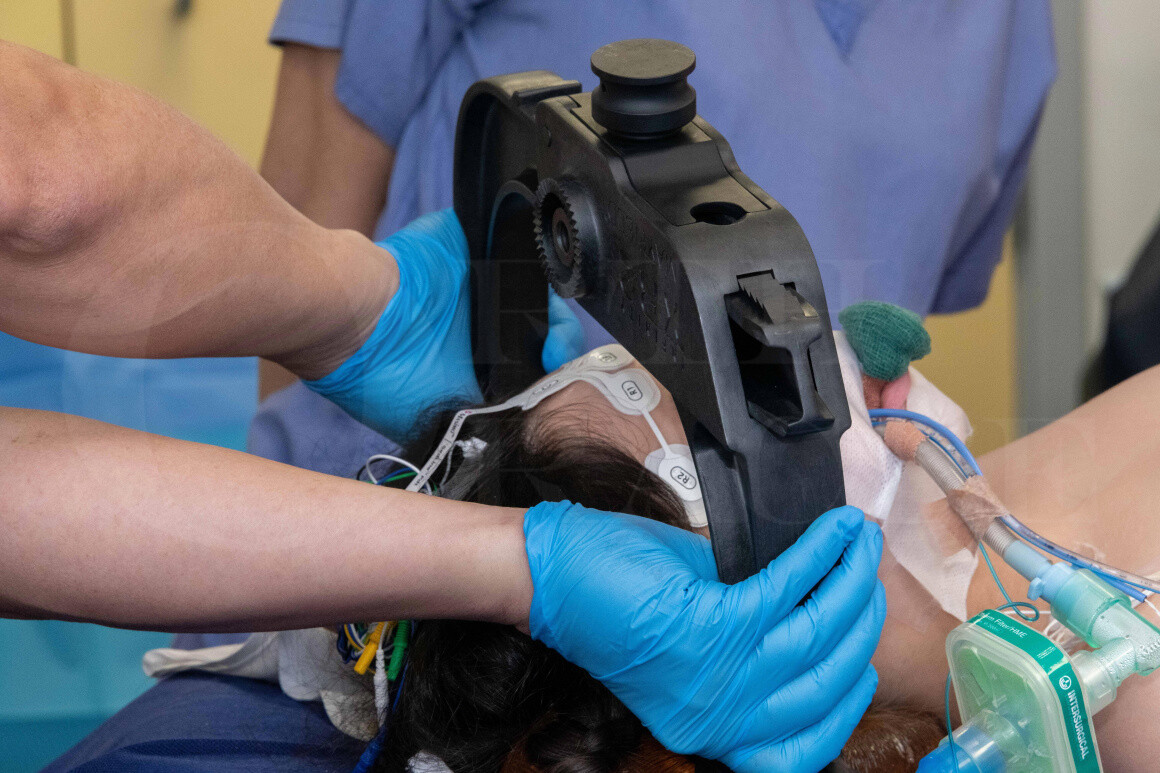Skull-Skeletal Traction for correction of Adolescent Idiopathic Scoliosis (INTEGRA MAYFIELD infinity XR2 System)
Overview

Subscribe to get full access to this operation and the extensive Spine Surgery Atlas.
Learn the Skull-Skeletal Traction for correction of Adolescent Idiopathic Scoliosis (INTEGRA MAYFIELD infinity XR2 System) surgical technique with step by step instructions on OrthOracle. Our e-learning platform contains high resolution images and a certified CME of the Skull-Skeletal Traction for correction of Adolescent Idiopathic Scoliosis (INTEGRA MAYFIELD infinity XR2 System) surgical procedure.
There remains no consensus on the optimum surgical management of scoliosis curves greater than 90 degrees, but a combined anterior release and posterior instrumented procedure had generally been considered the classical treatment for treating severe rigid scoliosis.
Anterior release (anterior resection of the longitudinal ligaments, intervertebral discs and endplates of rigid segments) can be considered to increase spinal flexibility prior to posterior curve correction and instrumentation in severe (larger than 90°) or rigid (larger than 60° on residual side-bending film) scoliosis. Anterior release significantly improves the compliance of curves and thus permits a better correction of the deformity (Anterior release of scoliosis (access by thoracotomy)). It also improves fusion rates and in the thoracic spine aids correction of thoracic hypokyphosis.
Occasionally, for some larger and more rigid curves, an anterior apical osteotomy may be necessary to achieve adequate curve correction and balance in both coronal and sagittal planes (Scoliosis correction(neuromuscular): Anterior release and apical corpectomy).
Anterior surgery is however not without detriment; it does increase operative time and post-operative length of stay, and has a negative impact on pulmonary function (compared to posterior only approach).
In the past 20 years, with application of pedicle screw technology and three-dimensional correction of scoliosis techniques, one stage posterior-only pedicle screw instrumentation has been shown to have improved rigid fixation of the spine and resulted in improved scoliosis corrections. Many authors have reported that a posterior all-pedicle screw construction in the treatment of severe and rigid curves have achieved comparable coronal and sagittal correction when compared with the past combined anterior and posterior procedures.
Intra-operative skull-skeletal traction is an accepted practice in scoliosis surgery and many studies have shown its effectiveness in providing curve correction (with reduction in vertebral rotation and translation prior to incision) facilitating exposure and improving final outcome. Posterior-only surgery with intra-operative skull-skeletal traction can provide correction rates in the treatment of curves >100° that are comparable to rates obtained using the combined anterior and posterior procedure.
It is my view that intra-operative traction is useful for curves that exceed 80 degrees and I regularly use intra-operative skull-skeletal traction for such cases. I find it converts a large difficult curve into a more moderate one on the day of surgery (produces curve correction with reduction in apical vertebral rotation and translation prior to incision) thus making surgical exposure and pedicle screw insertion more straightforward, facilitates eventual scoliosis correction /final rod placement, and in my view, results in improved outcome (due to shorted operative time, reduced blood loss, less requirement for supplementary anterior procedures, gradual curve reduction throughout case aiding global alignment/correcting any truncal shift).
Intra-operative skull-skeletal traction is not without it’s risks. Intra-operative skull-skeletal traction is associated with at least 3 times the increased risk of intra-operative neuro-monitoring change compared with no intra-operative skull traction cases. Neurological complication caused by the axial traction for scoliosis has been well described. It is believed that the corrective forces can stretch the vascular structures of spinal cord and thereby interfere with blood supply making the spinal motor system vulnerable to ischemic insult. It is my view that such changes to the vascular structures of the spinal cord could very well occur secondary to the later instrumented correction and gradual intra-operative traction may improved the tolerance of the spinal cord for the later correction. Motor Evoked Potentials (MEP) are especially sensitive to spinal cord ischemia.
Here I describe my technique in applying intra-operative skull-skeletal traction in a patient undergoing posterior instrumented surgical correction of her Adolescent Idiopathic Scoliosis. In this technique I only describe the application and removal of intra-operative skull-skeletal traction. The posterior instrumented surgical correction was as described in an earlier operation technique Posterior Instrumented Adolescent Idiopathic Scoliosis Correction and Fusion (T4 to L4) using Globus CREO system.
I use a the INTEGRA MAYFIELD infinity XR2 Skull Clamp System and MAYFIELD infinity XR2radiolucent base unit operating table attachment, but other company systems will be available.
OrthOracle readers will find the following associated instructional techniques also of interest:
Author: Mr Neil Upadahay FRCS (Tr & Orth)
Institution: The Avon Orthopaedic Centre, Southmead Hospital, Bristol, UK.
Clinicians should seek clarification on whether any implant demonstrated is licensed for use in their own country.
In the USA contact: fda.gov
In the UK contact: gov.uk
In the EU contact: ema.europa.eu
Online learning is only available to subscribers.



















